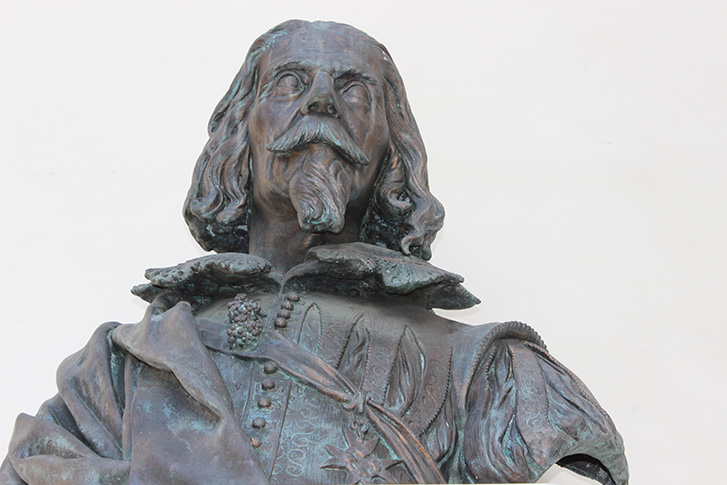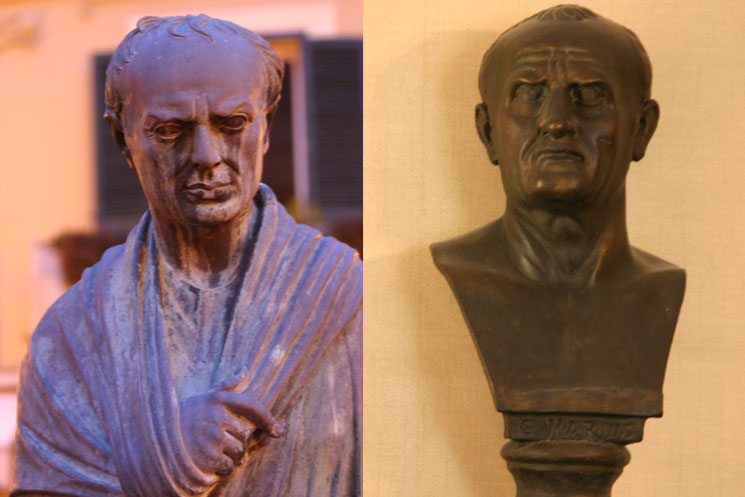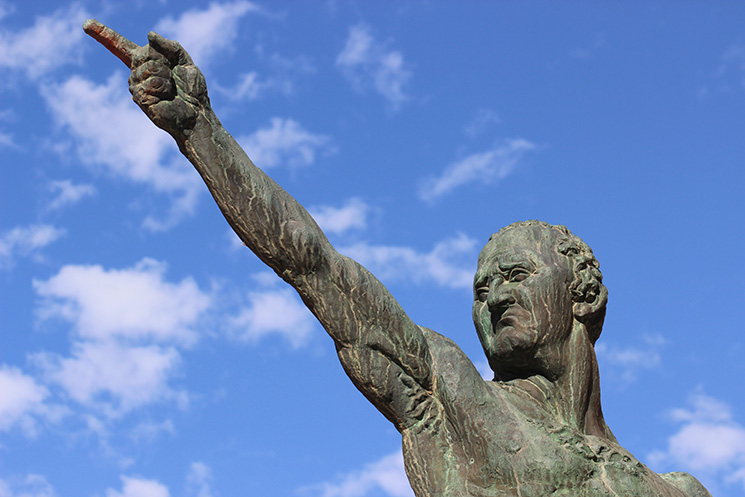Figli Illustri
Giuseppe Cesari

Giuseppe Cesari was born in Arpino in 1568 to a poor family that in 1582 moved to Rome. Here the young Giuseppe began to work as a shop boy in the painting of the Vatican Loggias. During the years of his training he learned from Taddeo Zuccari the mannerism style of the late 16th century. Since 1586 he was admitted to the “Congregation of the Pantheon Virtuous”.
He worked at the Palace of Cardinal Sartori, head of the Inquisition, and in the Churches of Trinità dei Monti, St Silvestro al Quirinale, St Lorenzo in Damaso. He then went to Naples and frescoed the Sancta Sanctorum of St. Martino Charterhouse, a work completed by his brother Bernardino.
Under the protection of Pope Clemens VIII the Cavalier d’Arpino lived the most important and prolific period of his artistic life. Among his many works, he painted the frescoes cycle in the Sala dei Conservatori in Campidoglio and Jesus Christ Ascension in St. John Lateran. He made the cartoons for the mosaics of St Peter’s Dome and he frescoed the Paolina Chapel in St. Maria Maggiore.
In 1615-20 he arranged the building of a Palace at the entrance of Arpino and he lived there during his stays in his birthtown. Here, he painted many pictures of religious theme, that can be admired in the town churches.
Figurative arts have had great representatives in Arpino: the Cavalier d’Arpino and his brother Bernardino Cesari, who was an important painter too; the sculptor Domenico Mastroianni, founder of an artist family comprising his son Alberto, sculptor and caricaturist, his grand-child Umberto, a worldwide famous sculptor, his two great grand-children, Marcello, a great and never-forgotten actor, and Ruggiero, an esteemed film editor.
Mastroianni worked in Paris, where he made an important series of clay models, and in Berlin and Wien. His studio in via Margutta in Rome was the place where Umberto trained. In Arpino Mastroianni sculptured the War Memorial (in corso Tulliano) and a bronze bas-relief dedicated to the Tulliano pupils died during the First World War. Among those who distinguished in the field of arts, Pasquale Rotondi (1909-1991) was an art critic and director of the Central Institute for Restauration; during the Second World War he saved thousands of works of art from Nazi plundering.
Gaius Marius

He was born in 156 BC at Cereatae within Arpino territory. Born to a humble family who was tied to the hard and thrifty costumes of Latin peasants, Marius did not have the chance to learn neither the Roman nor the Greek culture. Yet his courage and military talent during his service in Spain gained him the respect of Scipio Aemilianus who chose him as his valiant follower.
Supported by the gens Metella he became tribune of people and during his mandate he took up the cause of the people. Although the Optimates opposed him, he was called by Ceciliu Metellus as legate to his camp in Africa during the Jugurthine war. As he was elected consul, he ended quickly and decisively the war and took Jugurtha to Rome as a prisoner.
He was exceptionally elected consul five times in a row (104-100 BC) as Rome wished to entrust his most valiant commander the defence of the land whose borders were threatened by the Teutons and the Cimbrians.
He reformed tactically and socially the army which fought under the insigna of the eagle that he chose as symbol of the Roman legions. The Germans were defeated once and for all at Acquae Sextiae (Aix en Provence) and at Campi Raudii.
At the height of glory Marius did not forget his birthland. He donated Arpino the conquered land of the Cisalpine Gaul, whose revenue helped to support the town’s temples and public buildings. In the ethomology of the Camargue there are still traces of Marius’ presence (Caii Marii Ager).
As a politician Marius was not so successful. He supported the programme of the people party and he became their hero; but a conflict arose between him and the aristocrat Lucius Silla and led to a bloody civil war with ups and downs. Finally defeated he went into exile to Africa. He was called back and elected consul for the seventh time as many foretellings had predicted. Plutarch tells for example that seven eaglets had been found near his cradle. Few days after the election, Marius cought fever and died. It was the year 86 BC.
Alatri - Santina Cimatti
VITA: nel 1889 si consacrò Suora Ospedaliera della Misericordia, presso la casa madre di San Giovanni in Laterano a Roma ed assunse il nome di Suor Maria Raffaella. Dal 1893 lavorò presso l’ospedale di San benedetto ad Alatri, ma poi fu trasferita all’ospedale Umberto I di Frosinone, dove dal 1921 ricoprì anche l’incarico di Priora della comunità. Dal 1928 al 1940 ritornò ad Alatri, ricoprendo la carica di Superiora dell’Ospedale. Durante i duri anni della guerra si distinse per l’opera di conforto e di sostegno alla popolazione locale, nonché per l’aiuto medico che portò ai malati ed ai feriti. Quando ci fu il timore di un bombardamento alleato su Alatri, Raffaella, in collaborazione con il vescovo della città riuscì a far cambiare il piano strategico al generale Kiesserling.
Marcus Tullius Cicero

Marcus Tullius Cicero. Greek Κικέρων, Kikérōn. He was a lawyer, politician, writer, orator and Roman philosopher. He came from a wealthy municipal family of the Roman equestrian order, and is widely considered one of Rome's greatest orators and prose stylists. His large literary production, going through political orations and rhetorical and philosophical writings, offers a precious portray of the Roman society during the last troubled years of the Republic and represented also an example for all the I century authors so much to be considered the Latin literature model.
Through the work of Cicero, great admirer of Greek culture, the Romans could also acquire a better knowledge of the philosophy. Among the greater contributions to the Latin culture, he created a philosophical Latin lexicon: in fact, he worked to find the equivalent of Latin term for all the specific terms of Greek philosophical language.
Among the more important works for the comprehension of Latin world there is the Letters (Epistulae, above all those ones to his friend Titus Pomponius Atticus) that offers several considerations about every events, letting people understand the real policy lines of Roman aristocracy.
Visite guidate: Centro Guide Cicerone:![]() 0775.211417 - 349.4981226
0775.211417 - 349.4981226![]() Fax: 0775.859011
Fax: 0775.859011![]() This email address is being protected from spambots. You need JavaScript enabled to view it.
This email address is being protected from spambots. You need JavaScript enabled to view it.![]() www.ciceroneweb.it
www.ciceroneweb.it
Marco Vipsanio Agrippa

Chi era: generale e uomo politico romano
Nato a: Arpino, nel 63 a.C.
Agrippa era di modeste origini. Era della stessa età di Ottaviano ed i due erano amici intimi dall'infanzia. Gli fu sempre a fianco dalla prima spedizione in Macedonia contro i Parti fin dalla sua ascesa all’Impero di Roma. Come governatore in Gallia, Agrippa domò gli Aquitani, pacificò i Germani. Ma le sue doti militari si rivelarono magnificamente quando con energia e rapidità seppe dare a Roma una base navale con la costruzione del Portus Julius (riunì i laghi di Averno e Lucrino) e una poderosa flotta. Al suo comando sconfisse Sesto Pompeo, vincendo nel 36 a.C. a Mylae ed a Naucholus, e annientò Antonio e Cleopatra ad Azio, nel 31. Agrippa ricevette l'onore di una corona navale per i suoi servizi in Sicilia. Si occupò, poi, delle Province Orientali con grandi successi.
Il suo cursus honorium iniziò con la pretura, poi fu per tre volte console ma non meno degna fu la sua opera di magistrato civile. Nel 33 a.C. fu eletto edile, adoperando le sue conoscenze di architettura a suo vantaggio, segnò il suo ruolo in questa carica effettuando grandi miglioramenti nella città di Roma, ristabilendo e costruendo acquedotti, ingrandendo e pulendo la Cloaca massima, costruendo bagni e portici, progettando giardini, teatri, portici, terme lussuose e monumenti che diedero alla città un volto imperiale.
Sue opere furono il Porticus Vipsaniae contenente la prima carta geografica mondiale (l’Orbis pictus) di cui aveva preparato i materiali, il pons Agrippae, la Basilica Neptuni e, infine, il Pantheon di Adriano, ricostruito secondo il progetto di Agrippa. Riporta nel frontone la legenda M·AGRIPPA·L·F·COS·TERTIVM·FECIT, che significa Marco Agrippa, figlio di Lucio, fece durante il suo terzo consolato. Inoltre diede uno stimolo alla pubblica esibizione delle opere d'arte. Come imperatore, Augusto più tardi vantò che "gli aveva trovato la città di mattone ma la aveva lasciata di marmo," grazie ai grandi servizi forniti da Agrippa sotto il suo principato. Di versatile ingegno Agrippa va ricordato anche come autore di orazioni e memorie. Morì nel 12 a.C. all’età di 51 anni.


 (+39) 0775.211417
(+39) 0775.211417






 Viale Mazzini, 69 03100 Frosinone
Viale Mazzini, 69 03100 Frosinone (+39) 0775.1880722
(+39) 0775.1880722